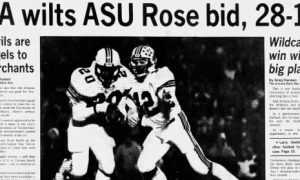FOLLOW @JAVIERJMORALES ON TWITTER!
[rps-paypal]
[ezcol_1half id=”” class=”” style=””]

— General history
— J.F. “Pop” McKale
— The games
— Comparisons then and now
— Wildcats nickname
— Military service
— Rankings
[/ezcol_1half]
[ezcol_1half_end id=”” class=”” style=””]
Excerpt from L.A. Times, Nov. 8, 1914, authored by Bill Henry:
“Arizona’s cactus-fed athletes, despite heroic efforts on the part of their two halfbacks, (Asa) Porter and (Franklin) Luis, went down to defeat before the Occidental Tigers yesterday afternoon, the tally with all precincts heard from being 14 to 0 in favor of the Tigers.
Confident of rolling up a big score, the Tigers took the field with grins on their faces, but before the game was 10 seconds old they knew they had a battle on their hands.
The Arizona men showed the fight of wild cats and displayed before the public gaze a couple of little shrimps in the backfield who defied all attempts of the Tigers to stop them.”This site will conduct a countdown in a 100-day period, leading up to Arizona’s 2014 football season-opener with UNLV on Aug. 29 at Arizona Stadium. The 100 Days ‘Til Kickoff countdown will include information daily about the historic 1914 Arizona team that helped create the school’s nickname of “Wildcats” because of how they played that fateful day against Occidental.
[/ezcol_1half_end]
[ezcol_1half id=”” class=”” style=””]
Football in 1914 was so unorthodox, at least by what we know of the game today, that the kicker was known as the “fullback” at that time.
The book The Anatomy of a Game: Football, the Rules, and the Men who Made the Game details the rules changes over the years. Some of the interesting practices in 1914 (when Arizona became known as “Wildcats”):
— Roughing the kicker (or fullback) penalties resulted in disqualification from the game. Running into the fullback, played at Arizona by Orville “Speedy” McPherson in 1914, on kicking plays was not an infraction.
— Roughing the passer was also an automatic disqualification. Before 1914, no rules were used to protect the quarterback. They were essentially open game.
[/ezcol_1half]
[ezcol_1half_end id=”” class=”” style=””]
[/ezcol_1half_end]

The 1914 Arizona football team that earned the honor of being named the first “Wildcats” was composed of (front row, left to right): Verne La Tourette, George Seeley, Leo Cloud, Richard Meyer, Asa Porter. Second row: Franklin Luis, Lawrence Jackson, Ray Miller, J.F. “Pop” McKale (coach), Turner Smith, Harry Hobson (manager), Orville McPherson, Albert Crawford, Ernest Renaud. Back row: Albert Condron, Emzy Lynch, Charley Beach, Vinton Hammels, Bill Hendry, George Clawson, Harry Turvey.
(AllSportsTucson.com graphic/Photo from University of Arizona Library Special Collections)
[ezcol_1half id=”” class=”” style=””]
— If a pass was incomplete out of bounds, the ball was turned over at the spot where it went out of play.
That rule lasted only the 1914 season because some teams continuously intentionally threw the ball down field out of bounds to win the fight over field position. It took away from the flow of the game.
— Drop kicks through the goal post by the fullback were a form of scoring. The play was an extension of rugby’s influence on the game.
At that time, the football was rounded on the ends similar to a ball used in rubgy, allowing for a better bounce to perform the drop kick. The goal post was at the goal line at that time.
[/ezcol_1half]
[ezcol_1half_end id=”” class=”” style=””]
[/ezcol_1half_end]
— The use of the two-layered leather helmets was not mandatory. Many of the players did not like to wear them because they interfered with hearing and were too warm to use. Halfbacks, who should have used them because they were targets of tacklers, thought they were too bulky and slowed them down.
The last drop kick in NCAA history in 1998:
ALLSPORTSTUCSON.com publisher, writer and editor Javier Morales is a former Arizona Press Club award winner. He also writes articles for Bleacher Report and Lindy’s College Sports.






















